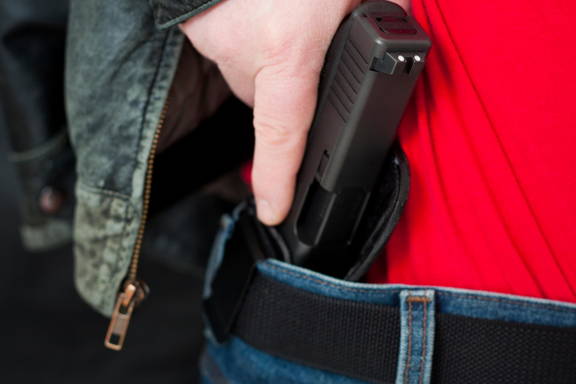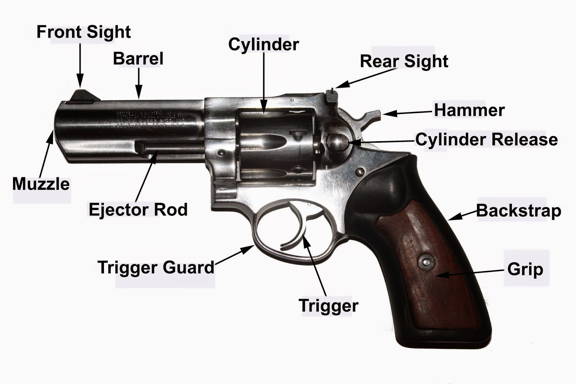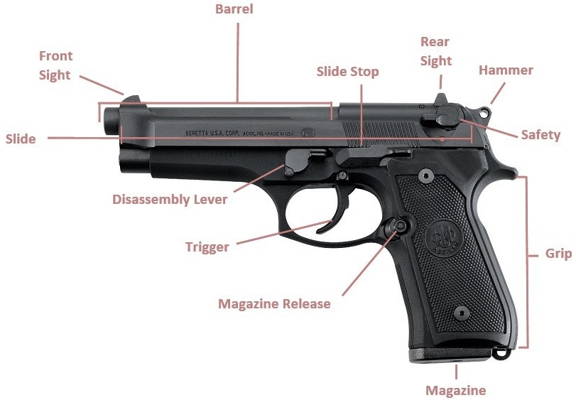→ Answer: Always use both hands when firing a pistol.
Explanation: A handgun should be operated with both hands when possible. However, this is not one of the basic rules.

Pistol Shooting Guide
If you seek a helpful concealed carry test study guide to get carry certification, we are here to help you out. Today, we are going to cover all topics you probably have to deal with on the exam.
In addition, we have taken all the following information from the latest carry class we have joined in a prestigious carry handgun organization. Though we have tried to provide as much information as possible, each guide has its specific curriculum.
The material we cover might not represent your entire lesson plan, yet our information might be covered at a minimum. Let's get the ball rolling.
Table of Contents
It is advisable to remember the following three rules related to firearm safety when taking questions on concealed carry test.
Each rule above is important to the safety of firearm handling. The first rule aims to ensure that a handgun malfunction or a negligent ejection can mitigate the risks of injuries.

Concealed Handgun
Thus, it is a fail-safe. Meanwhile, the second rule doesn't mean you have to let the finger put on the gun's trigger guard. You need to keep it on the pistol's frame to deter unexpected contact with it instead.
The third rule means you should not haphazardly leave the loaded firearm in case that can lead to injuries. When you shoot at a range, remember to unload, keep its magazine on automatics ejected and the action open if your gun is not in use. Should you want to know other safety rules, keep scrolling down to learn more.
That said, for the concealed carry test questions purpose, the rules mentioned above are the right answers.
Here are some questions about the general firearm knowledge test.
I will dive into the three key components of modern handguns. The test will likely cover the below information in different questions.
Besides, the questions also come with some common terms sounding like the right answers to puzzle you. Here are three key components you should remember.
Each handgun includes an action, frame, and barrel. That said, they are just three basic parts of a firearm. Look at the image below to know some other parts of revolvers and automatics, respectively.

What Inside A Revolver

An Automatic
There are two kinds of handguns based on their function: single-action, double-action, or both. This 2-in-1 type is commonly known as SA/DA. You can notice the animations of every different kind of trigger on this site.
You might wonder, "At which points are they different?". Well, to determine if a firearm is a single or double action, you can evaluate which action the trigger performs. If it both releases the cocks and the hammer when pulled back, your pistol is double action.
On the other hand, if it only performs to release the hammer, your pistol is a single action. It will need to get its hammer cocked by hand.
Lastly, if your trigger can work in either single action or double action, it’s a SA/DA pistol.
A revolver is different from an automatic in several key points. First, a revolver comes with various chambers, while an automatic has only one.
Moreover, the revolver uses a rotating cylinder known as the wheel, while the automatic uses a spring-loaded magazine to feed the rounds. Thus it would be best if you altered the magazine to reload automatics. That said, the revolver needs to empty the chamber by unloading through a port manually or the ejector rod. Next, the chamber will be loaded individually.
Lastly, the revolver rotates its wheel to change the chamber while the automatic eject a spent casing during the operation cycle.
As the revolver and automatic come with different designs, they feature different operation cycles. This cycle will define the process your pistol passes by when you fire a round.
You can also see a display of the automatic's operation cycle above. And here are seven steps in this cycle.

Ammunition
A cartridge is considered a "bullet." But it includes four separate parts as follows.
In particular, if pressing your reload, a primer will be one-time use and need replacement. It burns and generates pressure, ultimately forcing a bullet to go down a barrel regarding the fuel.
Today, bullets often use powder that doesn't release smoke, while traditional models use black powder. And finally, the bullet is a thing found in the muzzle. It is used to penetrate the target. It has various configurations, like a hollow point or frangible. That said, most consider the traditional models the ball ammunition. The shooter can use the casing to hold other round components in a unit. And brass is considered the most popular material, besides steel and others.
The spent casing is what remains in your pistol after firing a round. It is ejected and extracted when the automatic cycles. Then, we will get the primer. The pin to fire will strike the primer when squeezing the trigger, prompting the propellant's ignition.
Cartridges in handguns come in two kinds. Particularly, we will get rimfire ammunition to house a priming blend in the cartridge's rim. There is also centerfire ammunition.

Cartridges
This type of cartridge includes a priming texture in its primer in the middle of its casing head. Before going deeper into other parts, we want to emphasize why it is important to use cartridges specifically designed for handguns.
Accordingly, rimfire ammunition does not go with centerfire pistols. Moreover, different types and sizes of the cartridge aren't interchangeable!
We still have some exceptions, like a .38 ammunition is likely to be shot from a .357 magnum. That said, the bullet matches with the barrel doesn't mean the shooter can fire it from that specific firearm!
Nevertheless, you still need to consult a carry training manual; it is better to stamp the cartridge's caliber that a gun utilizes on the frame, slide, or barrel. Moreover, you can test the cartridge's caliber by going through the casing's bottom containing the primer.

Caliber Of Cartridge
Accurate shooting requires the entire body’s incorporation, not only the trigger finger. Thus, it is imperative to cover the topic of shooting stance. There are basically two stances for shooting: weaver and isosceles.
That said, each type has various variations, and these shooting stances are known as the extremes.
The weaver stance is, in fact, named after Los Angeles County Deputy Jack Weaver. And the key difference between a weaver and an isosceles stance is the way your torso and arms position. Particularly, your support arm will be bent more than your shooting arm.

Weaver Stance
Besides, the shoulders can be askew a bit rather than a square. Nevertheless, the body's lower shooting portion can be the same. Moreover, the feet are better to be shoulder-width apart and staggered. You can see the weaver shooting's example above.
It is one of the most popular shooting positions that can appear on your carry exam. This type of position is called based on the shape the arms make in conjunction with the body when seen from above.

Isosceles Shooting Stance
As you can see in the image above, the shooter's arms are extended, and they come with the body's centerline. Moreover, the shooting side foot's front aligns with the non-shooting side's instep. And in this common shooting position, your feet will be shoulder-width apart. That said, we have to say, there is no fixed stance for every shooter.
Most popular aiming issues inevitably originate from the sight picture or sight alignment. To make it clear, sight alignment is known as the link between the back sight and the front sight. Meanwhile, the sight picture relates to the accurately aligned sight position along with the target.
Our suggested solution is to aim a handgun with 3 dot sights. Accordingly, you will center the dot of the front sight between the two back sight dots. Make sure the top of the post from the front sight aligns with the back sight top.
When completed accurately, the 3 dots will be equally spaced apart and in a horizontal line. The focal point will be the dot on the front post to be placed on target.
Any stoppage in handgun operation cycles is likely due to the problem of ammunition. But it might also be due to the gun itself. The most popular reason for a gun stoppage is because of the ammunition. Regularly, this causes the failure to fire.
A fire failure means the shooter doesn't discharge the round after the pin strikes its gun's primer. When taking a carry test, all below sections might not cover all of your required materials. That said, a part of them can be present in the questions or answer section at least.
It is critical to familiarize you with them since there are also actual scenarios you can encounter.
One possible reason for stoppage is the squib load. It happens when the gun's firing pin strikes the primer, yet there's insufficient power to remove rounds from the gun's muzzle. Therefore, it can become lodged in your pistol barrel, resulting in a blockage.
A squib load is among the most serious kinds of stoppages. It can usually be identified by a pop sound rather than a bang when firing a round. That said, it is a serious stoppage due to the following round packed to the chamber during the cycle of operation.
In the next round, it can hit the blockage and can result in serious injuries.
Light strikes happen when the force of the pin hitting the primer is insufficient to ignite. Whenever the light strike happens, there is no clear sound from your primer.
The picture below shows the light strike of a .22 caliber rifle. You can see its cartridge remains intact, and its round is also there without discharging. That said, one of the most centerfire ammunition, the indentation from the pin, stays in the center on the sound's rear.

Light Strike
The extraction failure occurs whenever the casing doesn't leave a chamber in the operation cycle. It will lead to a stoppage as the following round of ammunition in the magazine is unlikely to be set into its chamber.

Failure To Extract
When this problem happens, the automatic can fail to reach its battery. In addition, it probably is a double feeding. However, the big difference is that the pistol isn't trying to consecutively load dual live rounds.
Unlike the extraction failure, this problem means the gun's casing possibly obstructs the cycles of operation, yet isn't stuck in its chamber.

Stovepipe
This issue can manifest in the casing form that sticks out the action top. Thus, it's referred to as a stovepipe due to its similarity to the stove's portion with a similar name. The stovepipe can hinder the pistol from reaching its battery.
It happens when the powder burns slowly and causes a holdup in the round's discharge. Like the problem of squib load, the hangfire might be very dangerous.
The pistol can lead to the active round of ammunition to lay on the grounds, and it can be discharged in all directions. Another same point between the squib load and the hangfire is the noise when you squeeze the trigger.
So what should we do in case of a firing failure? We will explain in the following part. Keep scrolling down to know.
Unluckily, when you squeeze the trigger, and your firearm does not discharge, we cannot identify if it's a hangfire, squib load, dud round, or light strike.
Thereby, you have to wait for about 30-60 secs with a muzzle pointed down before discharging the round. That said, we often make mistakes and wait about 60-90 secs before ejecting our pistols.
One more thing, it is advisable to clear the gun before proceeding. Visually inspecting the chamber and the barrel before carrying on your fire exercise is critical to avoid injuries.
A part of the concealed carry shooting tests is about responsible handgun ownership because your gun needs frequent maintenance. Besides, there is at least a question about how to clean your firearm safely.

Cleaning Set
Initially, don't forget to clear your gun and ensure to eject the magazine and empty the chamber. In no circumstances is there any live ammunition during the process of cleaning the gun. We assure you several forms of this inquiry are likely to be present on the test you are going to take.
Here is a mock test for your upcoming concealed carry quiz with included answers for your consideration.
→ Answer: Always use both hands when firing a pistol.
Explanation: A handgun should be operated with both hands when possible. However, this is not one of the basic rules.
→ Answer: Frame, Action, Barrel
→ Answer: True
Explanation: A revolver has a cylinder with multiple chambers that rotate to align with the barrel. Automatics have a single chamber and are magazine fed.
→ Answer: It means the trigger does two actions, releasing it with a single pull and cocking the hammer
→ Answer: Firing Pin
Explanation: The four components of a cartridge are the casing, primer, propellant, and bullet. The firing pin is part of the gun.
→ Answer: Decocking
Explanation: Decocking is not part of the normal cycles of operation of a handgun and requires a shooter to manually perform the action.
→ Answer: True
→ Answer: False
Explanation: The two types of cartridges are rimfire and centerfire. Hollow points and full metal jacket ammunition describe the treatment of the bullet, not the type of cartridge.
→ Answer: False
Explanation: You should only use ammunition made for the caliber of a handgun being fired.
→ Answer: A & B
Explanation: Sight alignment refers to the relationship between front and rear sights. Sight picture refers to the placement on target (point of aim).
→ Answer: False
Explanation: If the spent casing remains in the chamber, it is a failure to extract. A stovepipe is a failure to eject where the spent casing impedes the operation of the slide.
→ Answer: There is not enough pressure from a propellant to completely eject the round from the barrel.
Explanation: The first choice is a hang fire, and the third choice is a light strike
→ Answer: True
Explanation: NEVER keep live ammunition around when cleaning your handgun. Always drop the magazine and visually inspect the chamber to ensure it is empty before the field strip.
→ Answer: 30-60 secs
Explanation: You can wait longer, but 30-60 secs is sufficient. Do not eject the round if there is a failure to fire until at least 30 secs has passed!
We hope the sample questions on concealed carry test and our carry study guide above are helpful for you to prepare for the upcoming real test. We have attempted to vary all the kinds of inquiries to mimic what you can deal with on your test. It is best to go through our site for other information. If you are interested in finding more about any concealed carry classes, you can check our other articles. Each instructor has his approach of presenting materials.
Moreover, each state might have various requirements. Thus, you should ensure to know which state requires it when it comes to education.
Anyway, please feel free to let us know in the comment box below if you have any further questions. Thank you for reading!
Related articles: